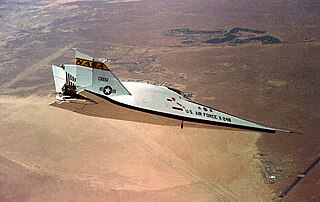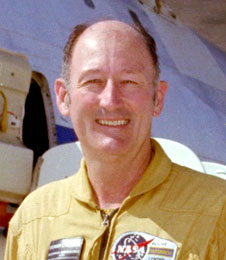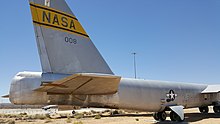
The North American X-15 is a hypersonic rocket-powered aircraft operated by the United States Air Force and the National Aeronautics and Space Administration (NASA) as part of the X-plane series of experimental aircraft. The X-15 set speed and altitude records in the 1960s, crossing the edge of outer space and returning with valuable data used in aircraft and spacecraft design. The X-15's highest speed, 4,520 miles per hour, was achieved on 3 October 1967, when William J. Knight flew at Mach 6.7 at an altitude of 102,100 feet (31,120 m), or 19.34 miles. This set the official world record for the highest speed ever recorded by a crewed, powered aircraft, which remains unbroken.

The Martin Marietta X-24 was an American experimental aircraft developed from a joint United States Air Force-NASA program named PILOT (1963–1975). It was designed and built to test lifting body concepts, experimenting with the concept of unpowered reentry and landing, later used by the Space Shuttle. Originally built as the X-24A, the aircraft was later rebuilt as the X-24B.

The NASA Neil A. Armstrong Flight Research Center (AFRC) is an aeronautical research center operated by NASA. Its primary campus is located inside Edwards Air Force Base in California and is considered NASA's premier site for aeronautical research. AFRC operates some of the most advanced aircraft in the world and is known for many aviation firsts, including supporting the first crewed airplane to exceed the speed of sound in level flight, highest speed by a crewed, powered aircraft, the first pure digital fly-by-wire aircraft, and many others. AFRC operates a second site next to Air Force Plant 42 in Palmdale, California, known as Building 703, once the former Rockwell International/North American Aviation production facility. There, AFRC houses and operates several of NASA's Science Mission Directorate aircraft including SOFIA, a DC-8 Flying Laboratory, a Gulfstream C-20A UAVSAR and ER-2 High Altitude Platform. As of 2023, Bradley Flick is the center's director.

The NASA X-43 was an experimental unmanned hypersonic aircraft with multiple planned scale variations meant to test various aspects of hypersonic flight. It was part of the X-plane series and specifically of NASA's Hyper-X program developed in the late 1990s. It set several airspeed records for jet aircraft. The X-43 is the fastest jet-powered aircraft on record at approximately Mach 9.6.

A mother ship, mothership or mother-ship is a large vehicle that leads, serves, or carries other smaller vehicles. A mother ship may be a maritime ship, aircraft, or spacecraft.

Pegasus is an air-launched multistage rocket developed by Orbital Sciences Corporation (OSC) and later built and launched by Northrop Grumman. Pegasus is the world's first privately developed orbital launch vehicle. Capable of carrying small payloads of up to 443 kg (977 lb) into low Earth orbit, Pegasus first flew in 1990 and remained active as of 2021. The vehicle consists of three solid propellant stages and an optional monopropellant fourth stage. Pegasus is released from its carrier aircraft at approximately 12,000 m (39,000 ft) using a first stage wing and a tail to provide lift and altitude control while in the atmosphere. The first stage does not have a thrust vector control (TVC) system.

Joseph Albert Walker was an American World War II pilot, experimental physicist, NASA test pilot, and astronaut who was the first person to fly an airplane to space. He was one of twelve pilots who flew the North American X-15, an experimental spaceplane jointly operated by the Air Force and NASA.

X-15 Flight 91 was an August 22, 1963 American crewed sub-orbital spaceflight, and the second and final flight in the program to fly above the Kármán line, which was previously achieved during Flight 90 a month earlier by the same pilot, Joseph A. Walker. It was the highest flight of the X-15 program.

Milton Orville Thompson, , better known as Milt Thompson, was an American naval officer, aviator, engineer, and NASA research pilot. He was one of twelve pilots who flew the North American X-15, an experimental spaceplane jointly operated by the United States Air Force and NASA.

Air launching is the practice of releasing a rocket, missile, parasite aircraft or other aircraft payload from a mother ship or launch aircraft. The payload craft or missile is often tucked under the wing of the larger mother ship and then "dropped" while in flight. It may also be stored within a bomb bay, beneath the main fuselage or even on the back of the carrier aircraft, as in the case of the D-21 drone. Air launching provides several advantages over ground launching, giving the smaller craft an altitude and range boost, while saving it the weight of the fuel and equipment needed to take off on its own.

John Barron McKay was an American naval officer, World War II pilot, aeronautical engineer, test pilot, and astronaut. He was one of twelve pilots who flew the North American X-15, an experimental spaceplane jointly operated by the United States Air Force and NASA. On September 28, 1965, he flew the X-15 to an altitude of 295,600 feet (90,100 m), thereby qualifying as an astronaut according to the United States definition of the boundary of space. However, this altitude did not surpass the Kármán line as defined by the FAI, the FAI-accepted boundary of 100 kilometres (62.1 mi).

Fitzhugh L. "Fitz" Fulton, Jr., , was a civilian research pilot at NASA's Dryden Flight Research Center, Edwards, California, from August 1, 1966, until July 3, 1986, following 23 years of distinguished service as a pilot in the U.S. Air Force.

The Boeing B-52 Stratofortress is an American long-range, subsonic, jet-powered strategic bomber. The B-52 was designed and built by Boeing, which has continued to provide support and upgrades. It has been operated by the United States Air Force (USAF) since the 1950s, and NASA for over 40 years. The bomber can carry up to 70,000 pounds (32,000 kg) of weapons and has a typical combat range of around 8,800 miles (14,200 km) without aerial refueling.

Stargazer is a Lockheed L-1011 TriStar built in 1974, that was modified in 1994 for use by Orbital Sciences as a mother ship launch pad for the Pegasus launch vehicle. As of October 2022, 45 rockets have been launched from it, using the Pegasus-H and Pegasus-XL configurations. As of 2019, Stargazer is the only L-1011 airframe still airworthy.

The Conroy Virtus was a proposed American large transport aircraft intended to carry the Space Shuttle. Designed, beginning in 1974, by John M. Conroy of the Turbo-Three Corporation, it was to incorporate a pair of Boeing B-52 Stratofortress fuselages to form a new craft using existing parts for cost-savings. While the project was seriously considered, it proved impractically large and NASA chose to develop the Boeing 747–based Shuttle Carrier from surplus commercial aircraft instead.

A drop test is a method of testing the in-flight characteristics of prototype or experimental aircraft and spacecraft by raising the test vehicle to a specific altitude and then releasing it. Test flights involving powered aircraft, particularly rocket-powered aircraft, may be referred to as drop launches due to the launch of the aircraft's rockets after release from its carrier aircraft.

Spirit of Mojave, previously Cosmic Girl is a Boeing 747-400 aircraft. A former passenger airliner operated by Virgin Atlantic, it was purchased by Virgin Galactic in 2015 to be used as the first stage launch platform for the air launch stage of the smallsat orbital launch vehicle, the LauncherOne. In 2017, the aircraft was transferred to the orbital launch subsidiary, Virgin Orbit, and its livery updated to Virgin Orbit. LauncherOne attempted its first launch on 25 May 2020; the launch was a failure. The first successful launch took place on 17 January 2021.

The North American X-15's Flight 188 on October 3, 1967, was a record-setting flight. William J. Knight took the X-15A-2 hypersonic rocket-powered aircraft to 102,100 feet over Mud Lake, Nevada when Flight 188 reached a record-setting top speed of 4,520 mph (7,270 km/h), Mach 6.70.





















